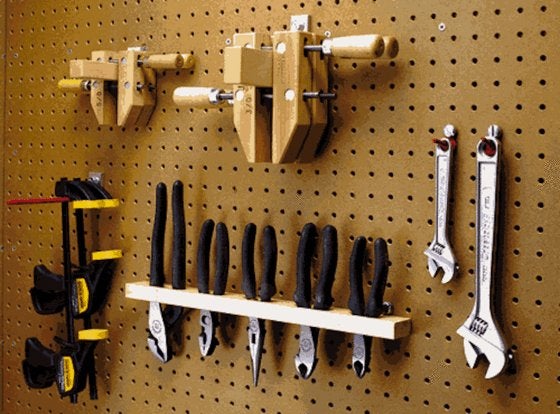Sporting Goods Store Design Tool
How To: Store Your Tools in Your Workshop (and Keep Them Accessible)
Keeping your tools visible and at the ready will make your workshop more efficient. Read on for top tips on accomplishing this worthy goal.

Photo: tedswoodworking.com
One of the great advantages of a workshop—as distinct from a toolbox carried to a workplace—is the opportunity to put your tools on what I like to call working display. I don't mean you are showing them off (you probably won't be giving many tours of the workshop anyway). I'm talking about exhibiting your tools to yourself, right there where they are needed, for your eyes to see and your hand to reach out and touch them.
Use Your Wallspace
In a well-planned workshop, there should be a minimum of rummaging through a tool box in search of a cold chisel. Instead, put the walls around you to work holding your tools
The pegboard with bracket approach has been in use at least since the days of Ozzie and Harriet and those cardigan sweaters Ozzie always wore. Pegboard may be something of a cliché, but that doesn't make it all bad.
Perforated hardboard is widely available and inexpensive; the prefabricated hangers are also commonplace, affordable, and to be found in a variety of shapes and sizes. The hangers do seem to have a tendency to release and drop to the floor and I, for one, think it's overkill to draw individual tool silhouettes behind each hanger. But hey, if it works for you, do it.
Perforated hardboard can be bought in eighth-inch and quarter- inch thicknesses; use the sturdier stuff if you plan to suspend any power tools from your rack. The board should be firmly attached to furring or one-by battens (screws and washers are a stronger and more permanent means than nails). The furring will provide the space necessary behind the board for hooking the hangers. The battens should be firmly attached to the studs in a wood-frame wall (drywall screws are a good solution) or with masonry nails and construction adhesive to a concrete surface.
There are a variety of somewhat more expensive but improved systems that offer even more flexibility. Most have prefabricated sections that can be mixed and matched to suit any array of tools. Some designs feature hangers that clip firmly in place. Most are designed to be fastened to wall studs spaced at standard sixteen-inch intervals. Shop around, and buy what you like.
- Many tool suppliers and direct mail catalogs sell magnetic strips for wall mounting. They can hold pliers, wrenches, screwdrivers, chisels, and other steel hand tools. Hang one over your workbench.
- Hooks attached to the wall or ceiling have their place, too. A push stick hung strategically over a table saw, for example, is easily accessible—and more likely to get used.
- Shelves are easy to knock together—no high-art joinery is required here, just sturdy and square surfaces on which to rest planes and handheld power tools and just about anything else portable.
- A perennial trick is to adapt old kitchen cabinets. They may be unstylish in the kitchen, but in the workshop who cares? Solid box cabinets make for safe and secure storage of tools, hardware, and other goods.
As you organize your workshop, don't forget that some of your tools will probably be used not only within the confines of the shop but elsewhere, too. Some of the tools will be trade-specific, designed for use on electrical work or painting jobs or plumbing. You might want to consider designating certain areas or containers for different tasks: a portable tool bag for the plastering tools, an open-topped tool carrier for plumbing supplies and tools, that portable workbench for the odd carpentry task.
Tool Cabinets
Closed cabinets are preferable to open shelves because less dust is likely to penetrate the closed doors (though some will) and coat the tools. They don't necessarily have to be pretty, and can be fixed in place, fastened to a wall, or stowed in a utility area. Or they can be portable, ready to load into your pickup and go to work down the street.
Planes are best stored on their sides, preferably with their blades withdrawn; never, never with metal nearby that could come into contact with the plane irons. A shelved cabinet is ideal for them.
Drawers
Drawers are a good place for small tools and, in particular, for sharp ones. A cabinetmaker's bench, for example, has drawers that suit chisels, scrapers, and other hand-held shaping tools.
A shallow drawer is appropriate for small tools like jeweler's drivers, alien wrenches, drill bits, and saber-saw blades. You might consider installing a drawer in your bench for holding such small items.
Sporting Goods Store Design Tool
Source: https://www.bobvila.com/articles/2151-how-to-keep-your-tools-accessible/
Posted by: kellyficket.blogspot.com

0 Response to "Sporting Goods Store Design Tool"
Post a Comment